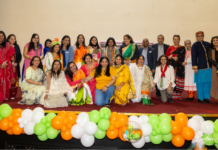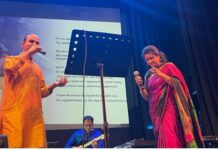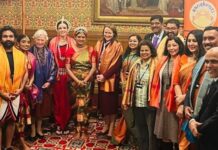Wither Indians, Bharatiyata & Sanskriti?
Dr.Sudha Vashisht
The build-up for the celebration of 50 years of HSS in the UK had been tremendous. Everyone I met was really excited and looking forward to the Sanskriti MahaShibir. The details and programme had been prepared meticulously and the painstaking preparations paid off. The sun shone for the 3 days of the Shibir. It was extra special for me as the Shibir was held on my birthday! We had an opportunity to reminisce about the early beginnings of the Shakhas in Ilford, where we had grown up. The Virat Hindu Sammelan was a landmark event which my parents had attended in 1989 in Milton Keynes.

The speakers at the Shibir were excellent. There had been a fairly intimate audience with Mohan Bhagwat. The baudhiks were really stimulating. The Smaroop was wonderful with tens of thousands of people arriving for the event on that sunny Sunday. We came back with a feeling of a stronger identity and energised in the Hindu cause.
These feelings were still fresh and alive in my memory, as I prepared to go to India 2 weeks later for a holiday. I would meet my daughter in India. We would travel together, hear and speak Hindi. We would eat Indian food and do many other things that all Indians do in India. We would connect with Bharatiya Sanskriti. This was especially poignant after attending the Sanskriti Mahashibir.

Dilli antarrashtriya havaiadda (Indira Gandhi Airport) is welcoming, despite the heat of August. Perhaps it’s because I had attended the Sanskriti MahaShibir, I was keen to review and analyse the Sanskriti in Bharat. So it was a real shock to see so much that was not Sanskriti. There is a lot of non-Sanskriti in Bharat now. Sadly, there was a lot of anti Sanskriti.
I recalled my last visit 2 years previously, and I had noted that the Roman script was becoming more ubiquitous. I was hoping things would change so that more Devanagari script would be seen in public places and public buildings. There is little visibility of Devanagari in Dilli antarrashtriya havaiadda. Nearly everything is written in English. The advertisements are in English. The shop signs are in English. The posters are written in English. The posters are of blond haired women wearing skirts. The special offers are written in English. The new shops are English, American and Spanish. There is a WH Smiths at the airport. There is a bar which serves alcohol, and only alcohol, all day. Curiously there is only one Bharatiya dukaan in the airport with a Hindi name, written in Roman script. It’s unbelievable. I go to Bharat to learn and see Sanskriti and the Sanskriti is disappearing in the rajdhani of Bharat.

A shopping Mall in Delhi
I go to the transit area of Dilli havaiadda. The anti Sanskriti is even more visible. A domestic airline, Indigo is conspicuous for its blue uniform of skirt, blouse and tights. Those wearing it are brown skinned. I am dismayed to see young Bharatiya jawans serving other Bharatiya log on this airline, in that uniform. This is a domestic airline and there is no convincing explanation for the airline to have such an anti- Sanskriti uniform. There is an advert being shown repeatedly promoting the Vistara airline. It is largely a domestic airline. The whole message of this advert is that it is not for the average Indian. The actor is a famous one, dressed in non-Indian attire, as many of the Indian film industry people usually are. This airline is for the unIndian Indian, in India. It is for the non- Indian, perhaps they are anti- Indian as well. Why has Indigo, a domestic airline chosen such non-Bharatiya attire? I cannot for the life of me fathom this out. Dilli is somewhat cosmopolitan, but when I see this again in Chandigarh, it looks even more strange and out of place.
We travelled to Jabalpur. It is said this is the Hindi belt area of Bharat. A drive through its City Centre did not confirm the strength of Hindi in this Hindi heartland of Bharat. Many of the shop signs are in English. There is American popcorn for sale. There are large boards on buildings announcing that English Classes are held there. The driver says ‘yes ma’am’ and ‘thank you’. Hindi bhi boil jate hai, lekin English ka jor hai. Yeh yanhan kaise aaya? Yakeen nahin aata ki Hindi yanhan par bhi kamzor ho rahi hai.
We go to the tourist places to see marble and stone. The craftsmen do beautiful handiwork on the stone. It is so curious that all the carved names, which are mostly Hindi names are written in the Roman script, in this area which is known as the Hindi heartland of Bharat. Some of the tourists may be those pesky NRIs, but many of the NRIs can speak and write Hindi. Yet the villager, who states that he is unparh (uneducated), carves ALL the names in the Roman script.
It is worse in Chandigarh. This was a city built in the early days after Independence. Hindi had lost its hold even in those days. Nearly every road sign is written in Roman script only. No one has thought to review this, or revoke this. Shukar hai ki nai havaiaddah par Chandigarh ka naam Punjabi aur Hindi main likha hua hai. Han- English main bhi likha hua hai.

Govt Museum -Chandhigarh
The names of the new build in India seems to have English names and titles. I would have thought the new build in India would be reviving its traditions and giving Hindi its rightful place. There are some who have done so in the past.
The educated middle class is hankering to be unIndian and non-Indian and are throwing the baby out with the bathwater. They probably don’t realise what they are doing. The children of middle class Indians go to study abroad, often to the UK or the USA. They are so keen to dilute and lose their identity. I do not think I know of many other people who are so keen to deny their identity and lose their identity. These ‘foreign returned’ students come back to India and reproduce what they have seen abroad, without using much intelligence. So the shops are called Coffee to Go and other such names written in English. The salons are called Special, Elite and similar names. The advertisements
have European women on the posters. The builders are making new malls called Shoppers Stop, Pacific Mall and other similar names. There is often English music to be heard in shops and malls. The builders make housing areas called Eden Gardens- I ask you Eden Gardens in Dilli?? As a Hindu I take offence to that. Why do they not use names such as Vakunth Dham, Triveni, Vatika and other Sanskriti related names?
The old housing estates are still called colony. such as Defence colony. Few new roads are called marg. There may be a handful of housing areas called basti.
It is often said that India has so much illiteracy, especially in the villages. Illiteracy is said to be a one of the major problems in India. I would agree. Those people are poor and not innovative. In some ways that is a huge blessing. I would ask who has done more damage to Bharat, and the identity of India? Is it the so called illiterate people of the villages? One can argue that they are the ones actually keeping the identity and Sanskriti of Bharat alive. They keep the indigenous languages alive and maintain original Hindu traditions. They dress in traditional Indian clothes. They have the Sanskriti. I would say Bhagwan ka shukar hai ki gaon main log unparh hain. Sanskriti un ke haathon main suraksheet hai.
There is a lot in India that is a reflective of its past. The past of the Moghuls and the British rule. Areas of French and Portuguese rule. Let’s not fool ourselves and call that India’s ‘rich’ history. That era of India was not rich for India or the Indians, but drained the country and its people of its wealth and Sanskriti. That part of history is steeped in a type of slavery which Indians are eager to maintain. The youth and many Indians are so confused about their identity, their Sanskriti, and are becoming unIndian, non-Indian and anti-Indian.
They are anti-Sanskriti.
(Views in the article are author’s Personal-Editor)

Readers like you, make ESHADOOT work possible. We need your support to deliver quality and positive news about India and Indian diaspora - and to keep it open for everyone. Your support is essential to continue our efforts. Every contribution, however big or small, is so valuable for our future.











